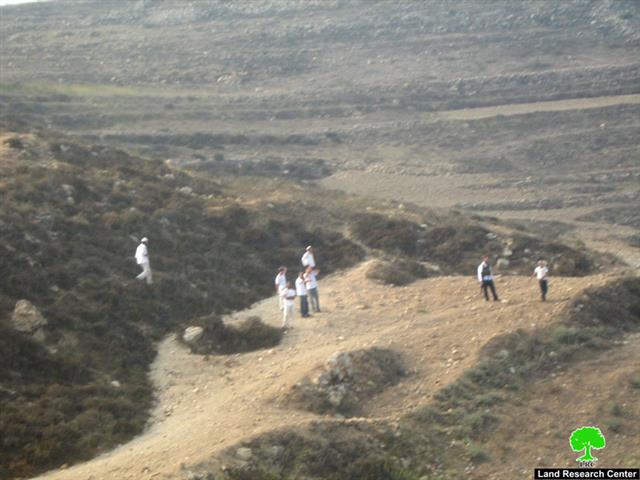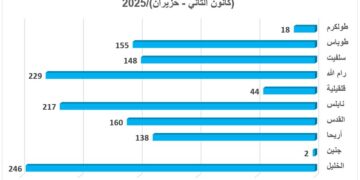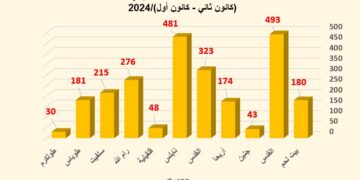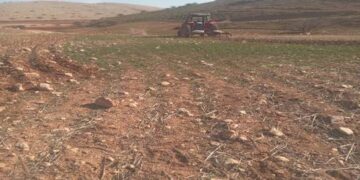On almost daily basis, colonists are continuing to carryout construction works on the location of the evicted colony of Homesh in Jabal Al Dohoor in Jenin. The colony was evicted in August 2005 along with the colonies of Sanoor, Kadiem and Ghaneim which were all located in the Governorate of Jenin. The locations of the four evicted colonies were not handed over to the Palestinian Authority; rather, Israel kept the locations under its authority until nowadays. All of the structures in Homesh (scattered over an area of 157 dunums) were destroyed and part of its ruins still present there.
The Withdrawal Game:
It is evident that the Israeli occupation was not serious about evicting the colonies; such forces foreclosed an additional 2,000 dunums in order to carryout the eviction back in 2005. Up until today, Israeli occupation forces prevent the owners of these lands from accessing or using it. Moreover, these forces are providing protection for the colonists in their attempts to re-colonize the place. This proves that the eviction of the colonies was only a ploy to gain international sympathy and deceive the world opinion while continuing to implement the colonization plans.
Photo 1 & Photo 2: Homesh colonists
Homesh Colonists’ Attacks Against Palestinians and its Implications:
The recent attacks carried out by the evicted colonists of Homesh on Palestinians and the attempts to re-build the colony confirms that there are Israeli hidden intentions to re-establish the colony. The presence of the Israeli occupation forces with the colonists as well as allowing the colonists to re-build uninterrupted are only two signs of the total cooperation between the occupation forces and the colonists.
Recently, the “Homesh First” Israeli movement has carried out a number of building activities at the site of the evicted colony while continuing their attacks on nearby Palestinians. These attacks included the following:
-
Attacking and causing property damages to Palestinian houses in the village of Barqa which overlooks the ruins of the colony. For example, in the late days of December 2008 Israeli colonists attacked the house of Mr. Nizar Hussein Seif and uprooted around 2000 vegetable bushes belonging to him. They have also attacked the house of Mr. Abdel Salam Mohammad A’aref Salam while destroying an animal shelter, the water irrigation network, stealing 5 of his sheep and emptying the fodder sacks he has recently purchased. The windows of the house of Mr. Khaled Faleh Salah were also broken while other colonists attacked the 75-year old Mr. Fahmi Hamed Daghlas near his land. He was moderately wounded and was transported to a nearby hospital. Colonists have also burnt 700 hay stacks belonging to Mr. Khaled Talaha Seif as well as 640 hay stacks owned by Mr. Musa Khalil De’alas.
-
The destruction and uprooting of all trees and bushes planted by the Palestinian farmers in the vicinity of the colony after its eviction in 2005. In addition, the colonists have destroyed 15 water cisterns and 2 agricultural roads established by the Palestinian Ministry of Agriculture in an effort to allow access for Palestinian farmers in the village of Barqa to their lands in the area.
-
Preventing Palestinian herders from grazing their sheep in lands located in the vicinity of the evicted colony. A number of incidents of stealing and even killing sheep were recorded. The last such incident took place in late November 2008 when colonists stole the sheep of Mr. Mufid Shaker Abu Obeid at gun point.
-
Israeli occupation forces had also a role to play in this saga as its soldiers provide protection for the colonists and cuts all the roads leading to the colony during their visits. At one incident, Israeli occupation soldiers opened fire at the street lamps of the village of Barqa while illuminating its skies to provide enough light for the colonists to carryout their attacks. In September 2008, the illumination flares caused a number of fires and damage to 100 dunums owned by Palestinian farmers west of the village of Barqa.
-
Also, Israeli occupation forces placed a number of military observation towers in January 2009 in the area of Jabal Al Dohoor where the colony of Homesh used to be located. The towers were meant to prevent Palestinians from coming close to the colony while providing full protection and cover to the colonists while placing mobile caravans, tents and electricity poles at the site of the evicted colony. This fact proves the complicity of the Israeli occupation forces with the colonists in their endeavor to re-establish the colony.
The Evicted Colony of Homesh:
The colony was established in 1980 on the boundary between the Nablus and Jenin governorates on the expense of the village of Barqa. It was built atop Parcel 6 of Jabal Al Dohoor on land pieces number 1 through 22. Until 2005, the colony had confiscated 1050 dunums of which 157 were its built-up area. Upon its eviction, there were 181 colonists living in the colony’s houses and 10 mobile caravans. In addition, there were around 4,000 dunums surrounding the colony that were considered to be a buffer zone to which Palestinians were prevented from entering or using for any purposes.
Yet, before the eviction was carried out, the Israeli occupation army issued on June 21st, 2005 a number of military orders (number T/97/05, T/98/05, T/200/05, T/201/05) which called for the confiscation of 2012 dunums of the lands of the village of Barqa. The declared purpose for the confiscation was to establish a military camp to be used in providing protection for the colonists during the eviction operation. These confiscations came atop earlier confiscations as 1950 dunums were seized in 2002 to be used for the construction of Road 60 connecting between the colony of Kadumim and the Tulkarem-Nablus Road junction.
Barqa Village: General Information
The village is located north east of the city of Nablus. Its area is 18759 dunums of which 702 dunums are located within the boundaries of its 1992 Master Plan. Around 90% of Barqa lands are registered in the Tabu. Approximately 5,000 dunums of its lands lay confiscated including the site of the evicted colony. The population of the village was estimated to be 4,000 Palestinians in 2005.
Photo 3: A general view of the village of Barqa
:::::::::::::__
[1] The colony was evicted in 2005 as apart of the ex-Israeli Prime Minister, Ariel Sharon’s Disengagement Plan. The plan included the eviction of 4 colonies in the West Bank one of which was Homesh.
Prepared by
The Land Research Center
LRC

















